By Steven Awalt
![]()
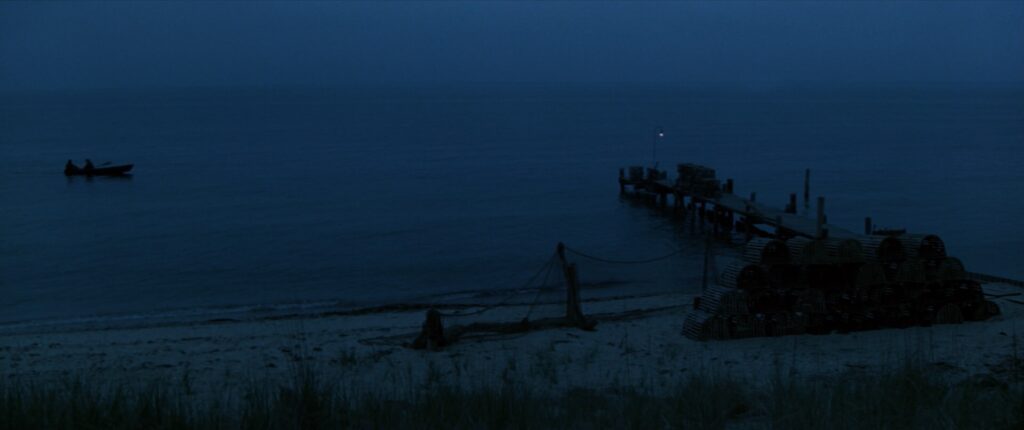
The famous “pier scene” in Steven Spielberg’s Jaws, which arrives just before the film’s 25-minute mark, is a scene that plays out as a pivot point from the tension-building pattern established in the previous shark attack scenes in the film but also presages aspects of what’s to come in the third act of the film. In under three minutes of screen time, Spielberg manages to ratchet up the tension of the film while turning it back on itself in a way that deviates from what’s come before, ending a scene of utter terror not with a complete release of our worst fears, but a sigh of relief and laughter.
First, let’s compare two drafts of the screenplay—the Peter Benchley draft and the Carl Gottlieb shooting draft—with the final film to illustrate how they differed from and related to Spielberg’s final film.
THE SCREENPLAY
Scenes 60 through 66/67: Exterior – Grassy Inlet (Ocean) and Pier – Night, three pages of script, follow the quick scene where Chief Brody, Deputy Hendricks and others post NO SWIMMING signs on the beaches of Amity.
Cut to that night and two islanders, Amity Selectman Denherder (a character previously seen in the film sitting two men to the left of Mayor Vaughn in the famed town hall meeting that introduces Quint) and Charlie, “a professional angler,” push a wheelbarrow onto a rickety old jetty. (In the Gottlieb shooting script and the final film, Denherder and Charlie arrive by boat.) The contents of the wheelbarrow include a “bloodstained laundry bag,” “a hundred feet of solid dog chain and a large patch inner tube,” as well as a “monster hook.” These items are used to bait the hook for their actual quarry: three-thousand bucks promised to the person or persons that land the alleged great white shark that devoured the mourning Mrs. Kintner’s son Alex.
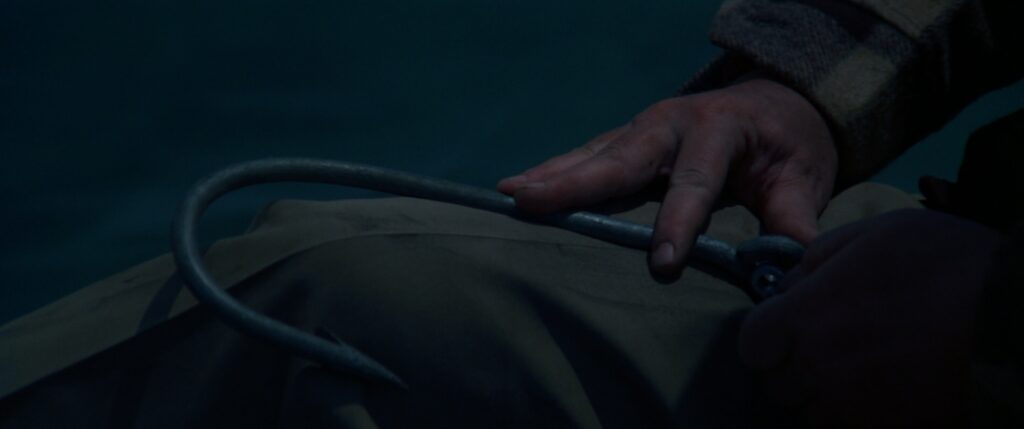
“Leg of lamb this time?” asks Denherder, to which Charlie responds, “Screw lamb—let’s shoot the sirloin.”
Denherder complains that these choice cuts of meat for chumming the shark are “blowin’ half the bounty on bait” while Charlie baits the hook with the steer and Denherder attaches the dog chain to a piling on the pier. Charlie attaches the inner tube to the chain near the business end of hook and chum, a bobber for their lure. Charlie throws the bait into the water and notes that the “tide’s taking it right out.”
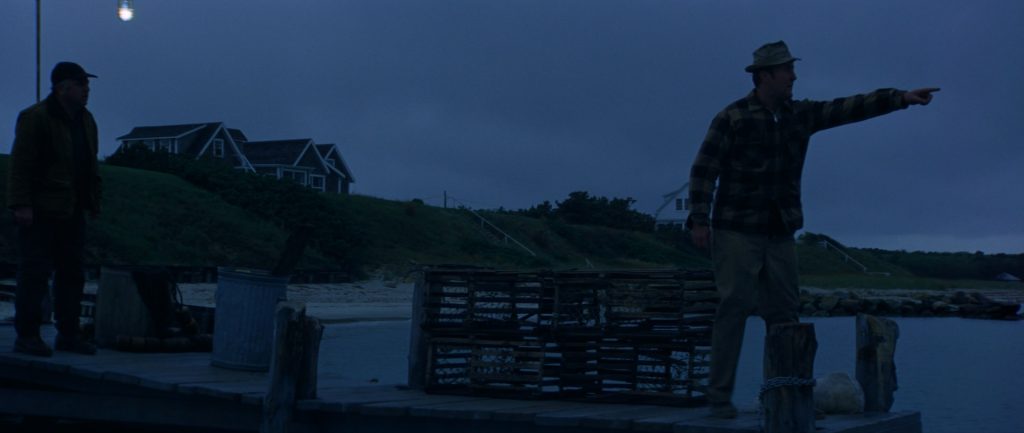
This bit of dialogue represents one out of three lines between Denherder and Charlie from 18 lines in the Benchley script which would wind up in the final film. Along with this line, the only other dialogue that subsequent shooting draft screenwriter Carl Gottlieb would hold over from the Benchley are “Go-go-go-go-go!” as the shark takes the bait out to sea and Denherder shouting “Charlie swim!” to his friend desperately trying to keep ahead of the swiftly pursuing great white.
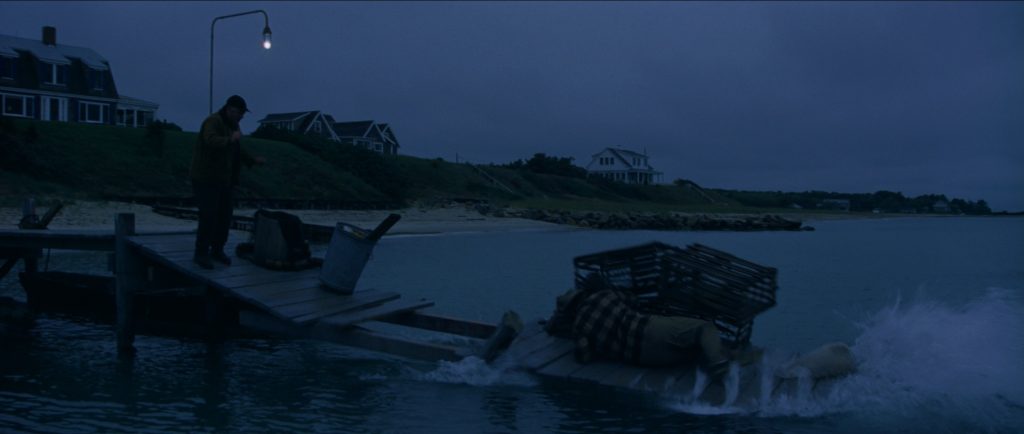
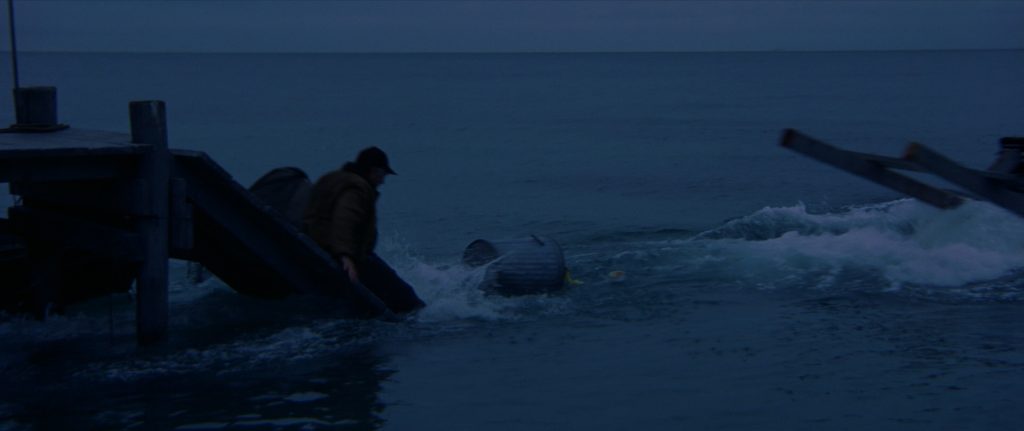
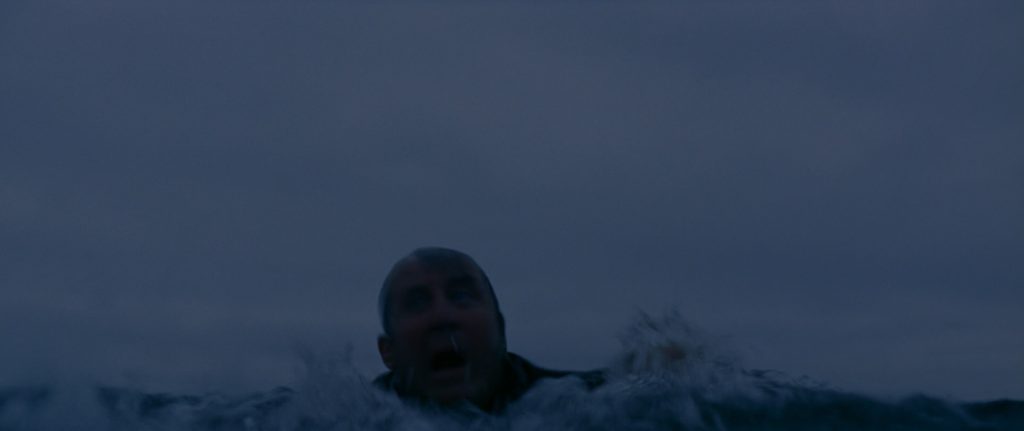
As for the action beats in the remaining pages the drafts, Spielberg’s final scene plays out very closely except for one key moment.
In the shooting script and film, Charlie makes it back to the jetty that still stands, scrabbling up the broken end of the pier as Denherder reaches down to grab his pal’s hand.
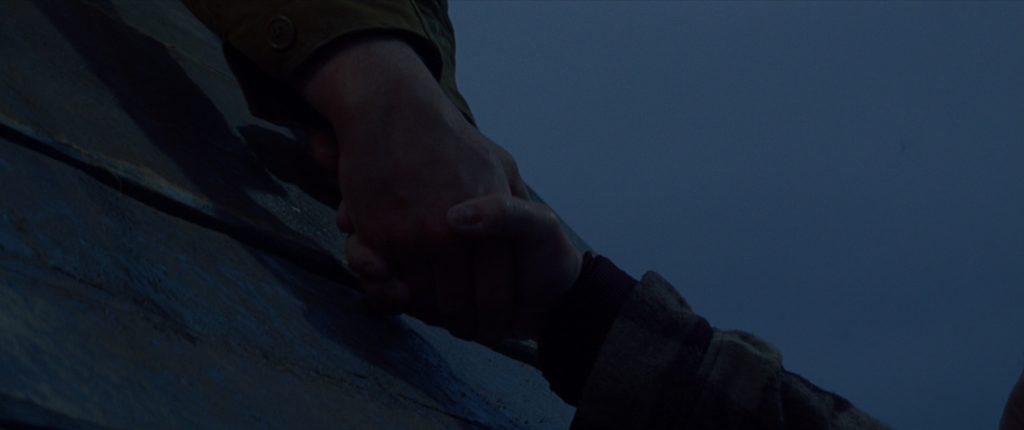
In the film, Denherder does pull Charlie to safety and Spielberg ends the scene with a comical note of relief. “Can we go home now?” exhales an exhausted, soul-spent Charlie, a callback to his asking the same at the head of the scene. As he tells his friend their hunt for the bounty is officially over, a piece of driftwood from the destroyed pier rolls in on the tide as the water reaches the shore.
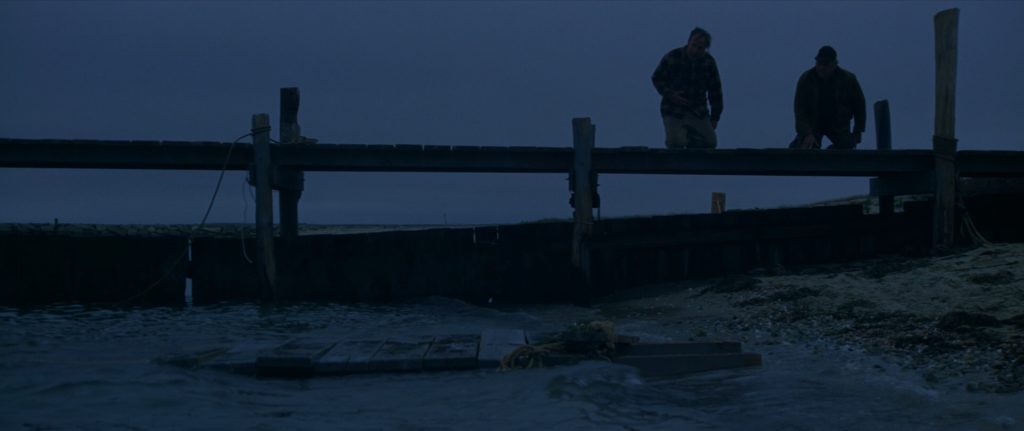
In the Benchley draft, however, both Denherder and Charlie wind up in the water when the pier breaks. Denherder pulls himself back up to the pier while Charlie is taken out to sea on the broken piece of the pier’s end. Benchley includes a funny detail that wouldn’t be at all out of place in Spielberg’s sense of character humor: the portion of pier that breaks away and gets dragged out to sea by the shark floats upright for a moment with “Charlie sitting dazed on top of it, his lit pipe still going.” He’s quickly dumped into the water, out away from the jetty and shore, completely exposed to the shark hungry for more than expensive appetizer of sirloin alone.
Once Charlie swims back to the jetty, the Benchley continues in a direction that Gottlieb and Spielberg will deviate from entirely. Although Denherder attempts to make it across the broken pier to help his friend, he’s unable to reach the end, leaving Charlie to scrabble up to find safety on his own.
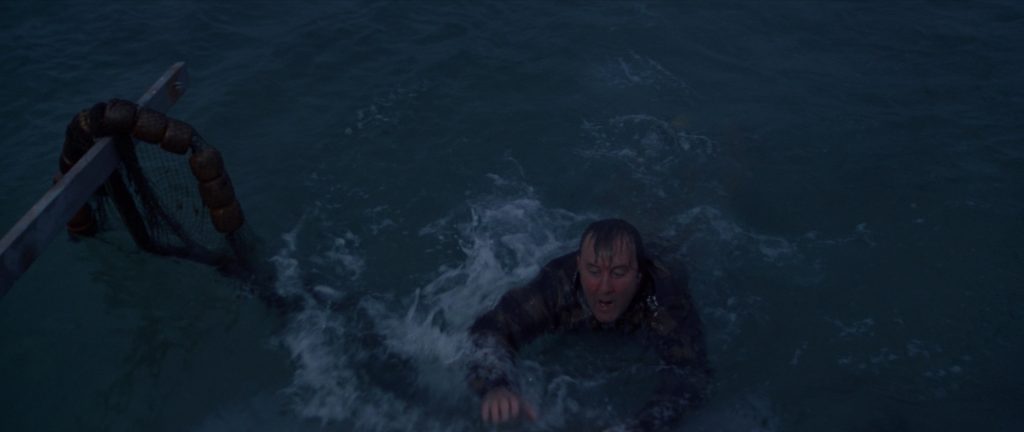
INSERT – CHARLIE’S HANDS
The algae is too slippery and his fingers keep sliding back. That’s when the fin behind him seems to reach up to the sky and—CHARLIE SCREAMS. An explosion of water and bubbles mercifully blot out the image.
It’s a harrowing end to a terrifying scene.
In the shooting draft and final film, Spielberg plays on his audiences’ fears that we’re about to see a scene as gruesome as those of Chrissie or Alex’s deaths, but in this case up close and present, only to see Denherder save Charlie at the very last moment. It’s a reprieve, a misdirect, and one that comes at the right time in the film since it deviates from the shark attacks’ set-up/horrible death pattern previously established. Spielberg twists the knife in the same fashion, but then suddenly pulls it out instead of driving it home. We’re relieved at the filmmakers’ sudden constraint, but it’s here where Spielberg actually pulls the pier out from under all of us since any shark attacks to come in the film leave us with a “will he or won’t he?” uncertainty. True screen terror thrives in such spaces of uncertainty.
SHOOTING THE PIER SCENE
Spielberg, crew, and locals Robert Chambers and Edward Chalmers, Jr., the two day-players actors portraying Charlie and Denherder respectively, arrived at Seascape in May of 1974, to enact and film the pier scene in a day-for-night shoot that would last for three days.
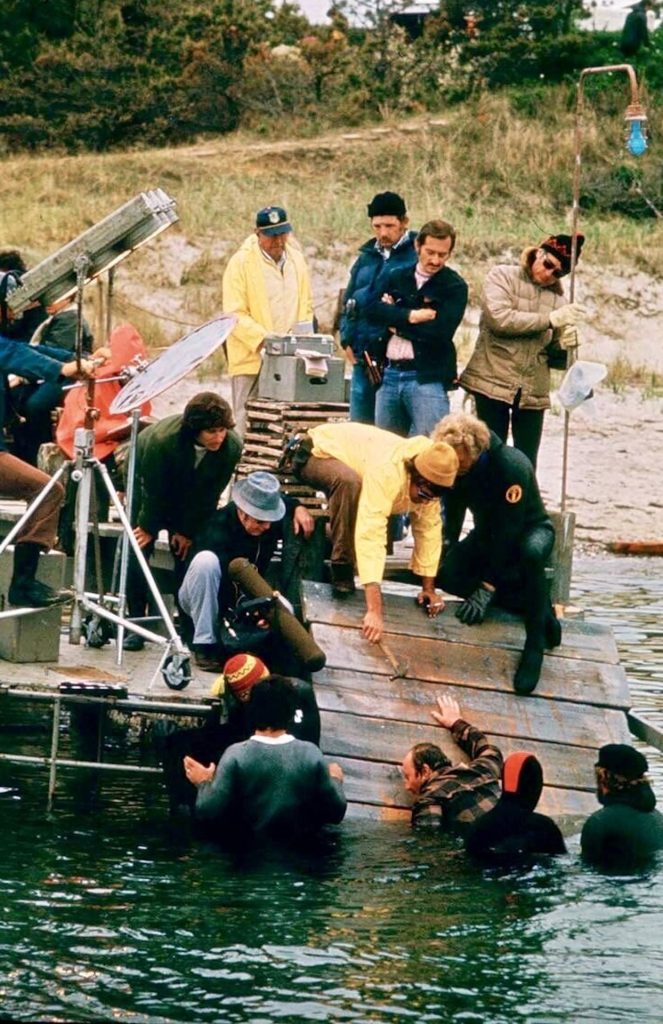
According to Vineyard resident and local documenter (in photos and words) of the Jaws production Edith Blake in her vintage On Location…On Martha’s Vineyard: The Making of the Movie Jaws, on the first day shooting the pier scene, “trucks lined the two-lane Oak Bluffs-Edgarton Road out front and clogged the drive, while the bluffs became bleachers [to watch the film shoot].”
The scene as depicted in the film is just over three minutes long, with a cut-away back to Chief Brody in the family room of his house, once again poring over the books on sharks and shark attacks he’s amassed for research. Events with Charlie and Denherder are depicted in 30 shots that run just over two-and-one-half minutes on screen, while the insert of Brody runs for 15 shots—many of them rapidly edited cut-ins on the pages with gruesome images of shark attack victims in the books he flips through—for nearly 80 seconds of screen time.
The production filmed on the pier itself and, when looking back from the water toward the pier yet above surface level, a rented ferry called “City of Chappaquiddick,” which called to immediate mind another tragedy, albeit a real world tragedy, of a poor soul who would wind up dying in the cold waters of the region.
Along with the small ferry Chappaquiddick were another five production boats anchored in support including Lynn Murphy’s fishing boat, itself rigged with cables and winches to the breakaway section of the pier. For the shot in which the end of the pier would break away from the unseen shark’s taking the bait and heading back to deeper waters with it, Murphy’s winches, positioned stern-side, would be pushed into action, taking the pre-scored piece of the pier—along with Charlie and sundry objects left on the pier—into the drink to join the unseen shark.
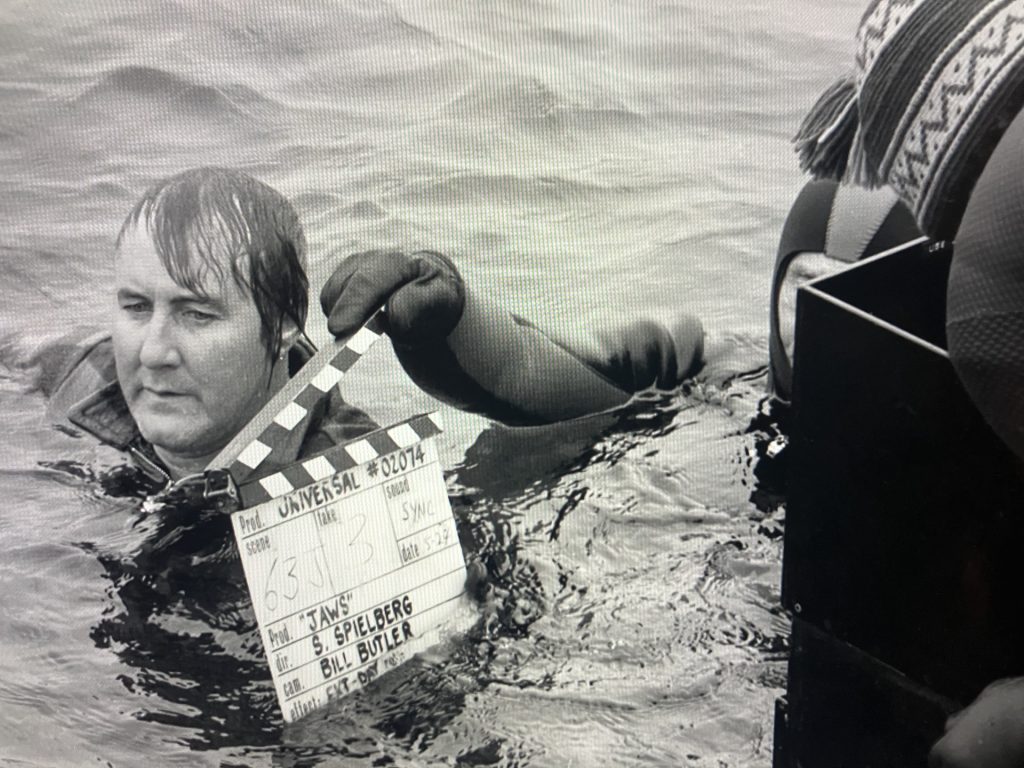
Also in those cold May waters were an assortment of crew members in wetsuits—Spielberg, “sparks” (electrical gaffers) laying cables to light the scene, grips, and Bill Butler’s camera crew which included Camera Operator Michael Chapman, Assistant Camera Operator Jim Contner and a special piece of equipment, a “splash-box” (as American Cinematographer would call it) of sorts in which to largely encase the Panavision Panaflex camera to allow the crew to shoot on—or even in, at least partially—the water itself.
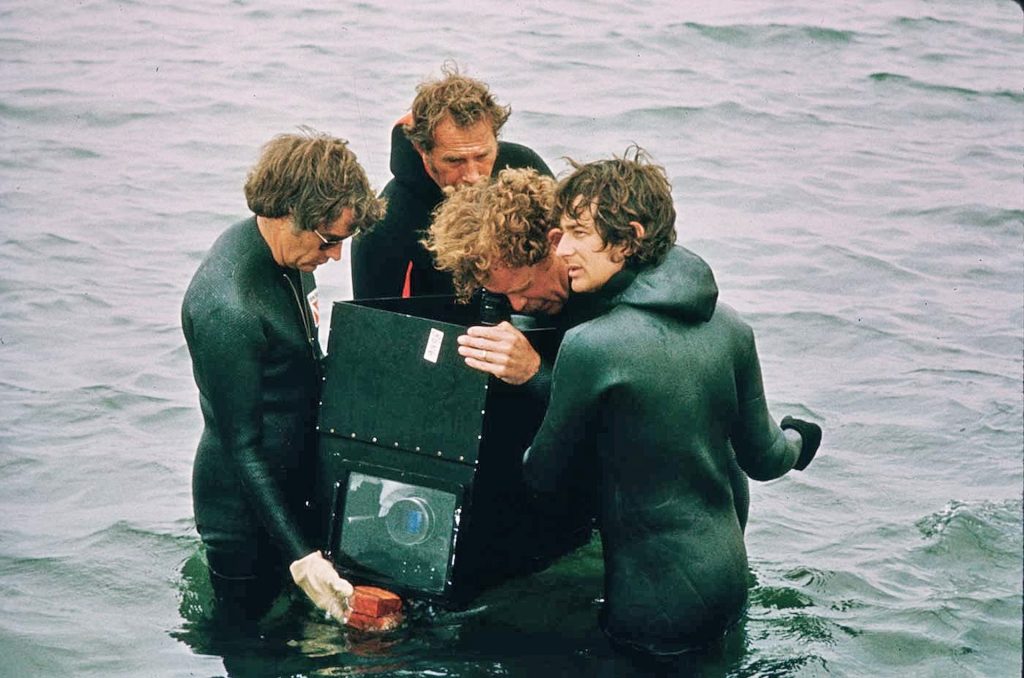
Both the splash box and the Panaflex were innovations borne of films connected to Spielberg leading up to Jaws.
Steven Spielberg’s 1974 film The Sugarland Express was the first major feature production to utilize the brand-new Panavision Panaflex. The Academy Award-winning cinematographer Vilmos Zsigmond shot Sugarland for Spielberg, their first collaboration. (He would subsequently, just after Jaws, shoot Close Encounters of the Third Kind (1977) with Spielberg, the film for which Zsigmond earned his Oscar.)
Prior to Sugarland, Zsigmond lensed the 1972 movie Deliverance for director John Boorman, a film set in the wilderness of Georgia with key sequences taking place in and on a river. The splash-box the Jaws production utilized, the very model, was built by Panavision for Deliverance at Zsigmond’s behest to allow him to bring his camera right down with the water in the thick of the action, sometimes even below the waterline. In order to protect the camera gear, a camera would be placed in the open-topped but otherwise sealed glass box with the box in turn placed into the water. The gear worked to great visual and emotional effect on the audience and proved to be the perfect piece of equipment for a film such as Jaws set largely off the beaches of Amity Island and out to sea. By placing viewers in the water with swimmers and shark, the tension level was amped up exponentially.
Butler took Zsigmond’s original inspiration with the water box and built and improved upon it for what would prove a more rugged shoot—with the tides of the ocean to contend with compared with Deliverance’s river shoot—and more usage of the device.
“If you look at the pictures [from the Jaws shoot] you’ll notice on the box, there’s an extension up high, you can see the screws,” said Jim Contner. “The original water box was half that height, and so Bill Butler had it extended thinking, ‘We’re gonna be in the surf and in the ocean, and to protect the camera, we needed to raise the height of that.’ So he had it redesigned.”
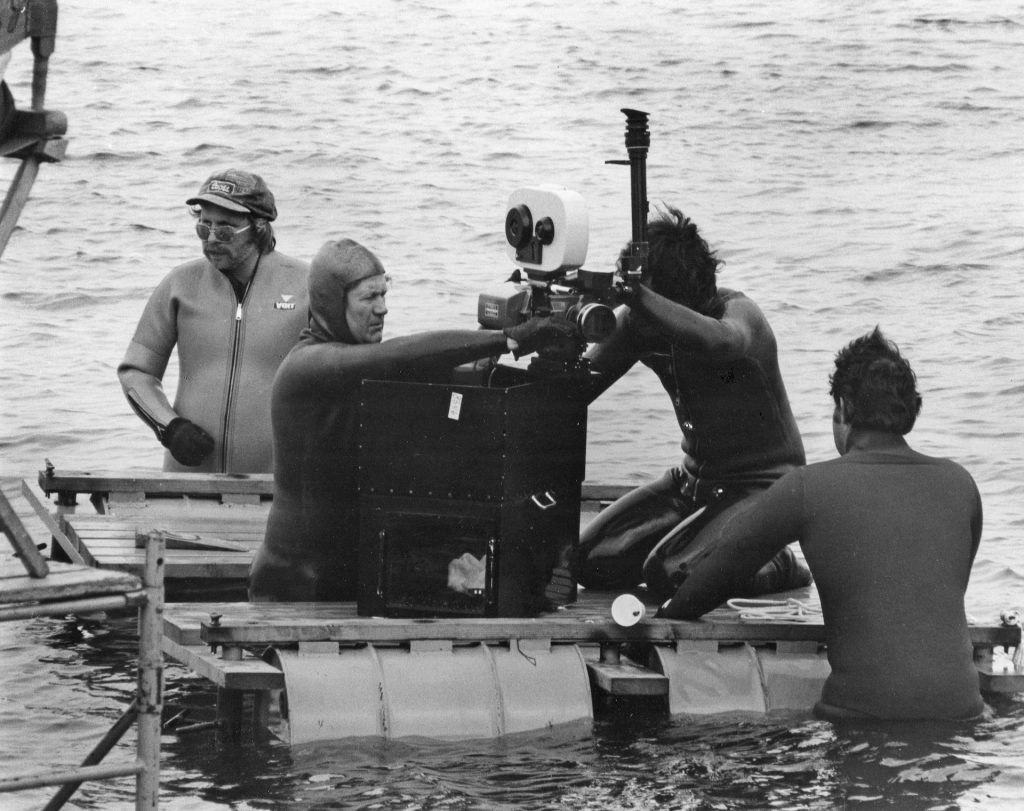
The water box was put to great use in Jaws, as Spielberg had it in mind when he conceived of how he’d shoot scenes and sequences set on the water throughout the running time of Jaws.
“Steven designed many, many shots around that thing,” Contner recalled. [For the pier sequence] “it’s usually mounted on a tripod with no head—just resting there because the thing was very heavy [about 34 pounds]. And that’s when we realized—I think Mike Chapman was very involved with this—we had the carpenters build us a specially designed raft with a cut-out where the water box is nestled…
The platform was buoyed by pontoons that could be adjusted to raise or lower the raft up from or down toward the water’s surface.
“Mike was able to stand on the platform and hold the water box and be able to dunk it in and out.”
One key shot in the sequence was picked up on the water at a later date that summer: the “oh hell no!” shot of the broken pier turning around and pointing back toward a panicked Charlie swimming toward the jetty.
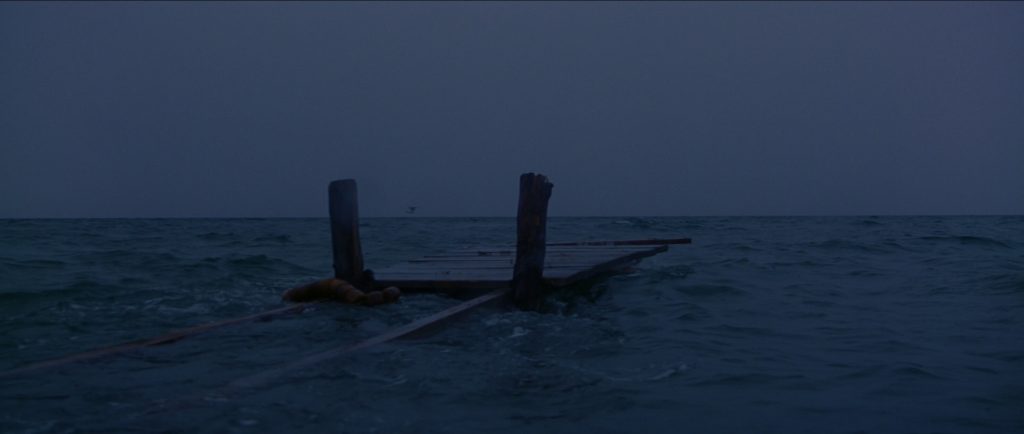
One last note on the scene as re-conceived from the Benchley draft by Gottlieb and Spielberg—Again, in the Benchley script, Charlie’s last bow isn’t one of relief, but tragedy. It’s probable Spielberg changed the end of the scene to, as discussed above, feint and parry from the established pattern of “shark attack results in death” to throw the narrative and audience off-balance for what’s to come in the second and third acts. From a purely practical consideration of production, however, the shark models were still not ready to go before the cameras. It’s possible Spielberg could’ve conceived shooting the screenplay in the way Benchley describes: we never get a good look at the shark, it’s all “an explosion of water and bubbles [that] mercifully blot out the image” of Charlie’s gruesome death, but perhaps glimpses of the shark’s fin, mouth, impressions of the full shark Spielberg is holding back from us, along with an explosion of water, bubbles and even blood, would’ve made for a spectacular cap to this scene. Instead, we get Denherder saving Charlie, in that powerful, fraught closeup of Denherder reaching his hand down to take that of his friend, to pull him up to safety, saving him from both injury and death.
Quint’s fate at the film’s end is foretold visually in this moment between Denherder and Charlie, but despite our hero Chief Brody reaching out to save the grizzled sea captain he’s come to respect, here the hero cannot save the day. As the Orca lists, deck tipping down toward the ocean and the open maw of the great white, Quint is holding on for dear life when one of Hooper’s damned compressed air barrels dislodges and rolls over Quint’s hand, making him lose his grip on his ship and cry out in agony from the crushing weight of the barrel. It’s here that Brody, himself desperately hanging onto the ruined Orca, reaches his hand out for Quint. The two men don’t grasp hands, they find one another deeper down at the forearm.
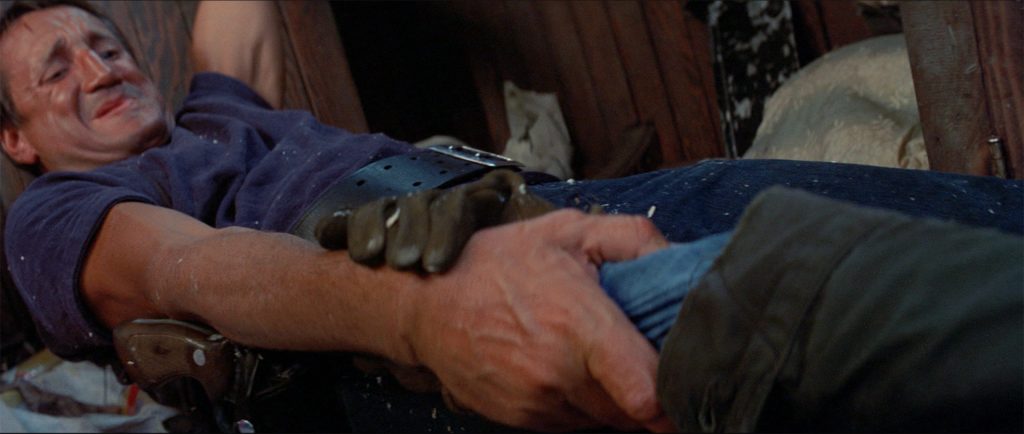
The tilt of his ruined ship toward the shark is too much and gravity pulls Quint’s hand down Brody’s arm, through his hand. Both men try to hold onto one another but it’s for naught as Quint slips away, down the deck of his boat and toward the jaws of his nemesis. He kicks desperately at the shark, again and again, but those massive teeth and jaws bite down on Quint’s legs, the sound of crunching bone, then up to his midsection as blood bursts forth from his stomach and his screaming mouth. Brody looks on helpless as Quint stabs the shark in the side of its snout with his machete, but the shark thrashes its head back and forth to take the fight out of his quarry. Quint lets out a final death scream choked with blood and the shark slides back into the deep, Quint’s head and outspread arms still visible between its teeth as the shark sinks back into the depths, taking the old seafarer down into the dark waters like most of his battalion that delivered the Hiroshima bomb nearly three decades prior.
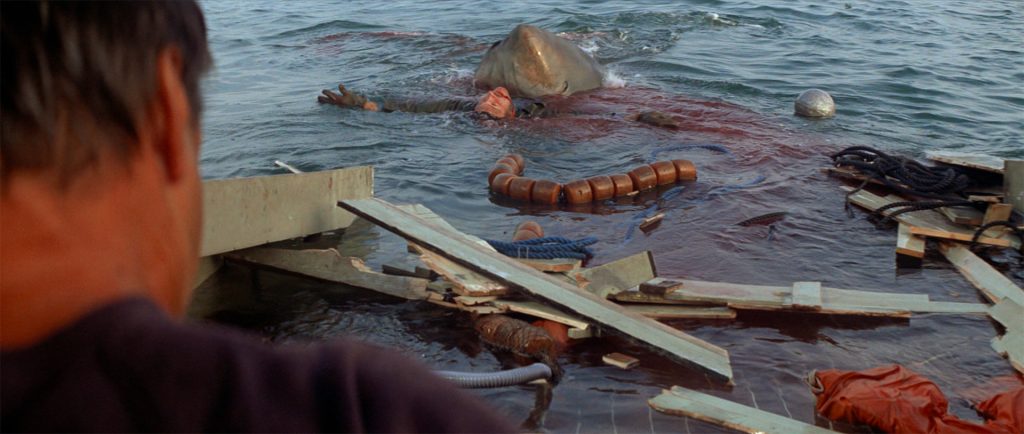
NOTES ON SOURCES
Steven Awalt consulted with Jaws screenwriter Carl Gottlieb and American Cinematographer articles on Jaws (“On Location with Jaws,” by Mik Cribbens, AC, March, 1975), The Sugarland Express (“Panaflex Camera Debuts on The Sugarland Express,” by Herb A. Lightman, AC, May 1973) and Deliverance (“On Location with Deliverance,” by Herb A. Lightman, AC, August 1971).